#Newspaper Rock State Historic Monument
Video
Church Rock by James Marvin Phelps
Via Flickr:
Church Rock Highway 191 Utah Very Near To Newspaper Rock State Historic Monument and the Needles District of Canyonlands National Park, this oddly shaped sandstone formation was erroneously associated with Marie Ogden’s nearby utopian community “Home of the Truth”. The rectilinear opening at the base of the formation was not, however, an attempt to hollow out the rock to make it into a church as local lore would have it (hence, Church Rock), but was in fact dynamited and cut out of the stone by the property owner during the 1940s to store salt licks and feed for cattle. (atlasobscura.com)
#utah#moab#chruch rock#chruch rock clouds#rock#sandstone#clouds#landscape#desert#sky#landscape photography#james marvin phelps photography#flickr
5 notes
·
View notes
Text
Day 8 Wednesday
Gallup to Bandelier National Monument
It was one of those days when things didn’t go as planned. Things didn’t go badly, just not as I anticipated.
We left Gallup and for a while drove the old Route 66 and then on to Petroglyph National Monument on the outskirts of Albuquerque. While yesterday we saw a few petroglyphs on Newspaper Rock today we saw dozens.


We took a short hike, which was actually more of a rock climb, where we saw many petroglyphs as well as a panoramic view of the area. It was interesting and we got some steps in. 👍

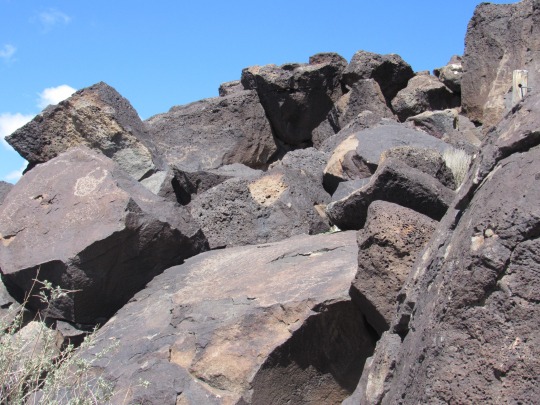
From there, I had planned to go to Valles Caldera Natural Preserve but when we finally got to the road to the visitor center, the road was mud and. covered in snow and slush. Definitely not fit for our motor home to travel.
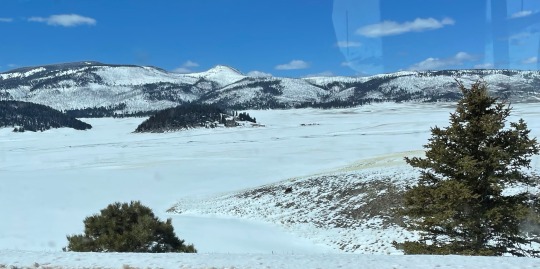
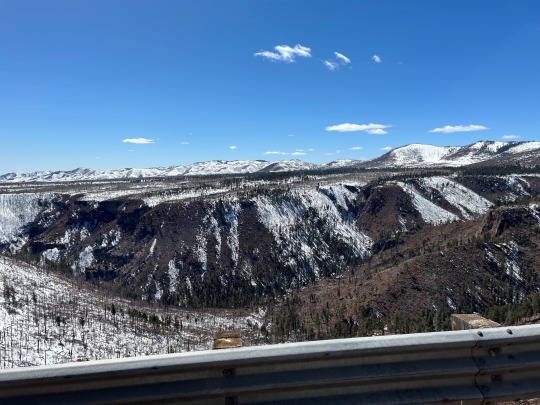
So we went on to Los Alamos and the Manhattan Project National Historical Park. Surprise! The visitor center is closed Tuesday, Wednesday and Thursday. So much for that stop too!
We moved on to Bandelier National Monument, a park I knew nothing about other than they have campgrounds (no hookups).


It turns out to be a beautiful place with lots of mountains, canyons and roads with many, many switchbacks. I got my stamp at the visitor center and we set up at the campground. It is very peaceful. I really do feel like I am camping. 😀
Today’s Miles: 268
Total Trip Miles: 2506
States; New Mexico States; New Mexico
0 notes
Video
youtube
NEWSPAPER ROCK STATE HISTORICAL MONUMENT - MONTICELLO - UTAH
Cordonnées GPS: 37.98822, -109.51812
Newspaper Rock est un site pétroglyphique situé à Monticello dans l'État de l'Utah. Plus de 650 dessins d'art rupestre sont présentés sur un panneau rocheux de 19 mètres carrés.
Ces dessins représentent des figures humaines, des animaux et différents symboles dont certains sont considérés de nature religieuse.
Les premiers pétroglyphes sur ce site ont été réalisés il y a environ 2000 ans par les amérindiens.
En Navajo, on appelle ce rocher "Tse' Hone'", ce qui signifie que c'est un rocher qui raconte une histoire.
***************
AUTRES VIDÉOS DE CE ROAD TRIP:
https://www.youtube.com/playlist?list=PLlRroQCNvchsdvRQOTUATm7OU6BabhYIF
ABONNEZ-VOUS ► https://www.youtube.com/c/SouthAngelVideo?sub_confirmation=1
SUIVEZ NOUS :
• BLOGGER ► http://southangelvideo.blogspot.ca/
• INSTAGRAM ► https://www.instagram.com/annestrasbourg/
• FLICKR ► http://www.flickr.com/photos/anne_strasbourg/collections/
• TWITTER ► https://twitter.com/AnneStrasbourg
1 note
·
View note
Text
The Newspaper Rock State Historic Monument is a Utah state monument featuring a rock panel carved with one of the largest known collections of petroglyphs. The first carvings at the Newspaper Rock site were made around 2,000 years ago, left by people from the Archaic, Anasazi, Fremont, Navajo, Anglo, and Pueblo cultures. In Navajo, the rock is called "Tse' Hone'" which translates to a rock that tells a story. There are over 650 rock art designs. The drawings on the rock are of different animals, human figures, and symbols. These carvings include pictures of deer, buffalo, and pronghorn antelope. Some glyphs depict riders on horses, while other images depict past events like in a newspaper. While precisely dating the rock carvings has been difficult, repatination of surface minerals reveals their relative ages. The reason for the large concentration of the petroglyphs is unclear.

5 notes
·
View notes
Note
I was wondering if you could point me to any resources on programming within jehovah's witnesses? Or if you know anything that was in connection or opposition to the Jehovah's witnesses to do with blood moons, child sexual abuse, torture (electric and waterboarding). Location is Derbyshire/Staffordshire, England, 2000-2007.
The Jehovah’s Witnesses use cult methodologies within their teachings, and are considered a cult by many.
Some of the methods are love bombing new members, financial control, if a member leaves they are shunned, and members can’t question authority.
If someone’s entire family are members of the Jehovah’s Witnesses this makes leaving a monumental undertaking.
The methods of control used by the Jehovah’s Witnesses and other cult groups follow the BITE model (Steven Hassan.)
Behavior Control
1. Regulate individual’s physical reality2. Dictate where, how, and with whom the member lives and associates or isolates3. When, how and with whom the member has sex4. Control types of clothing and hairstyles5. Regulate diet - food and drink, hunger and/or fasting6. Manipulation and deprivation of sleep7. Financial exploitation, manipulation or dependence8. Restrict leisure, entertainment, vacation time9. Major time spent with group indoctrination and rituals and/or self indoctrination including the Internet10. Permission required for major decisions11. Thoughts, feelings, and activities (of self and others) reported to superiors12. Rewards and punishments used to modify behaviors, both positive and negative13. Discourage individualism, encourage group-think14. Impose rigid rules and regulations15. Instill dependency and obedience16. Threaten harm to family and friends17. Force individual to rape or be raped18. Instill dependency and obedience19. Encourage and engage in corporal punishment
Information Control1. Deception:
a. Deliberately withhold information
b. Distort information to make it more acceptable
c. Systematically lie to the cult member
2. Minimize or discourage access to non-cult sources of information, including:
a. Internet, TV, radio, books, articles, newspapers, magazines, other media
b.Critical information
c. Former members
d. Keep members busy so they don’t have time to think and investigate
e. Control through cell phone with texting, calls, internet tracking
3. Compartmentalize information into Outsider vs. Insider doctrines
a. Ensure that information is not freely accessible
b.Control information at different levels and missions within group
c. Allow only leadership to decide who needs to know what and when
4. Encourage spying on other members
a. Impose a buddy system to monitor and control member
b.Report deviant thoughts, feelings and actions to leadership
c. Ensure that individual behavior is monitored by group
5. Extensive use of cult-generated information and propaganda, including:
a. Newsletters, magazines, journals, audiotapes, videotapes, YouTube, movies and other media
b.Misquoting statements or using them out of context from non-cult sources
6. Unethical use of confession
a. Information about sins used to disrupt and/or dissolve identity boundaries
b. Withholding forgiveness or absolution
c. Manipulation of memory, possible false memories
Thought Control1. Require members to internalize the group’s doctrine as truth
a. Adopting the group’s ‘map of reality’ as reality
b. Instill black and white thinking
c. Decide between good vs. evil
d. Organize people into us vs. them (insiders vs. outsiders)
2.Change person’s name and identity
3. Use of loaded language and clichés which constrict knowledge, stop critical thoughts and reduce complexities into platitudinous buzz words
4. Encourage only ‘good and proper’ thoughts
5. Hypnotic techniques are used to alter mental states, undermine critical thinking and even to age regress the member
6. Memories are manipulated and false memories are created
7. Teaching thought-stopping techniques which shut down reality testing by stopping negative thoughts and allowing only positive thoughts, including:
a. Denial, rationalization, justification, wishful thinking
b. Chanting
c. Meditating
d. Praying
e. Speaking in tongues
f. Singing or humming
8. Rejection of rational analysis, critical thinking, constructive criticism
9. Forbid critical questions about leader, doctrine, or policy allowed
10. Labeling alternative belief systems as illegitimate, evil, or not useful
Emotional Control1. Manipulate and narrow the range of feelings – some emotions and/or needs are deemed as evil, wrong or selfish
2. Teach emotion-stopping techniques to block feelings of homesickness, anger, doubt
3. Make the person feel that problems are always their own fault, never the leader’s or the group’s fault
4. Promote feelings of guilt or unworthiness, such as
a. Identity guilt
b. You are not living up to your potential
c. Your family is deficient
d. Your past is suspect
e. Your affiliations are unwise
f. Your thoughts, feelings, actions are irrelevant or selfish
g. Social guilt
h. Historical guilt
5. Instill fear, such as fear of:
a. Thinking independently
b. The outside world
c. Enemies
d. Losing one’s salvation
e. Leaving or being shunned by the group
f. Other’s disapproval
6. Extremes of emotional highs and lows – love bombing and praise one moment and then declaring you are horrible sinner
7. Ritualistic and sometimes public confession of sins
8. Phobia indoctrination: inculcating irrational fears about leaving the group or questioning the leader’s authority
a. No happiness or fulfillment possible outside of the group
b. Terrible consequences if you leave: hell, demon possession, incurable diseases, accidents, suicide, insanity, 10,000 reincarnations, etc.
c. Shunning of those who leave; fear of being rejected by friends, peers, and family
d. Never a legitimate reason to leave; those who leave are weak, undisciplined, unspiritual, worldly, brainwashed by family or counselor, or seduced by money, sex, or rock and roll
e. Threats of harm to ex-member and family
26 notes
·
View notes
Video
Petroglyphs and Prehistoric Rock Art at the Newspaper Rock State Historic Monument by Mark Stevens
Via Flickr:
As I'd begun to plan this trip with the many stops at national parks and monuments, a co-worker had mentioned this as a place worthy of a stop. For this image, I focused on one section that seemed to be covered from edge to edge with stories and art. I felt that that best captured the idea for this monument. Anyone could then image all the stories and history being written and told...
#Along Utah State Route 211#Ancient Pueblo Rock Art#Azimuth 66#Capture NX2 Edited#Color Efex Pro#Day 4#Desert Landscape#Desert Mountain Landscape#Desert Plant Life#High Desert#Indian Creek Canyon#Indian Creek Corridor#Indian Creek Corridor Scenic Byway#Indigenous Rock Art#Landscape#Looking ENE#National Register of Historic Places#Nature#Newspaper Rock#Newspaper Rock Recreation Site#Newspaper Rock State Historic Monument#Nikon D800E#Outside#Petroglyphs#Prehistoric Rock Art#Project365#State Route 211#Sunny#Tse' Hone#Utah High Desert
2 notes
·
View notes
Photo
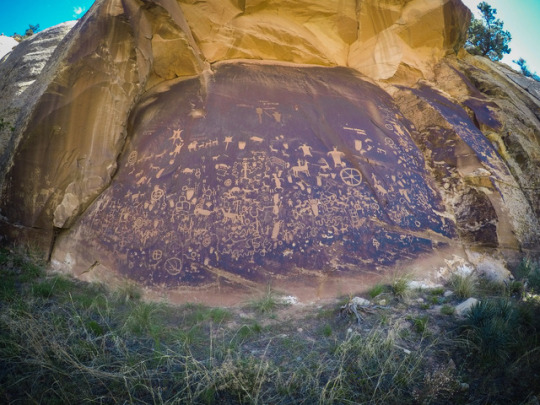
Newspaper Rock Petroglyphs, May 11 2017
1 note
·
View note
Text
Take a Virtual Tour of the Smithsonian American Art Museum's Humboldt Exhibition
https://sciencespies.com/nature/take-a-virtual-tour-of-the-smithsonian-american-art-museums-humboldt-exhibition/
Take a Virtual Tour of the Smithsonian American Art Museum's Humboldt Exhibition

SMITHSONIANMAG.COM |
May 1, 2020, 9 a.m.
It’s not what you’d expect from an art show. At the end of a long corridor, beyond a pulled-back heavy burgundy brocade curtain, a full-scale mastodon skeleton fills much of the rotunda-like space of the gallery. The fossil is the centerpiece of “Alexander von Humboldt and the United States: Art, Nature, and Culture,” an exhibition at the Smithsonian Museum of American Art. The show was poised to open with much fanfare earlier this year just as the COVID-19 crisis shuttered the museum. Today the stately mastodon sits waiting for crowds to return. In the meantime, viewers can go on a virtual tour of the show through a new video put together by the museum’s senior curator, Eleanor Jones Harvey.
For Harvey, the 11-foot tall, 20-foot long elephant ancestor is the uber statement on what polymath Alexander von Humboldt (1769-1859) meant to the American politicians, scientists, artists and writers who fawned over him during his brief six-week visit to the United States in 1804, and who became a part of his global network of admirers for a huge chunk of the late 18th and early 19th centuries.
The mastodon was a coup for SAAM—it is the first time the fossil will be back in America since 1847, when it made its way through Europe and ultimately ended up at The Hessisches Landesmuseum Darmstadt in Germany. A video shows the disassembly in Darmstadt and three-day reassembly at the museum.
youtube

Alexander von Humboldt and the United States: Art, Nature, and Culture
A Prussian-born geographer, naturalist, explorer, and illustrator, Alexander von Humboldt was a prolific writer whose books graced the shelves of American artists, scientists, philosophers, and politicians. Humboldt visited the United States for six weeks in 1804, engaging in a lively exchange of ideas with such figures as Thomas Jefferson and the painter Charles Willson Peale.
Buy
The mastodon—exhumed under the guidance of artist Charles Willson Peale and cobbled together with wood by a leading sculptor of the day—represents the intersection of art, culture and science, says Harvey. Similarly, Humboldt studied multiple disciplines and believed that “artists need to have enough scientific background to know what they are painting, and scientists should maintain a sense of aesthetic wonder to appreciate as they are collecting,” Harvey says.
Almost 300 plants and 100 animals are named after the Prussian-born naturalist. Have you heard of the Humboldt penguin? The Humboldt Squid, which swims in the Humboldt Current? How about the Humboldt lily, found in California, which also has a Humboldt County? Forests, rivers, peaks, mountain ranges and even a patch of plains on the moon have been named for him. Humboldt, who published 36 books, including his five-volume masterpiece, Cosmos, was a man of many interests—so many that it’s hard to catalog them all.
He mentored many young scientists and accumulated a vast network of admirers and collaborators through some 25,000 letters, often beseeching others to share findings from their explorations as a means of accumulating data to prove his “unity of nature” theory: that everything on the planet is interconnected, says Harvey. Humboldt may have been one of the first to warn about climate change, noting that the devastation of forests in Venezuela had changed the local climate.
Read more about Alexander von Humboldt in this article by Eleanor Jones Harvey

Exhumation of the Mastodon by Charles Willson Peale, ca. 1806-08
(Maryland Historical Society, Baltimore City Life Museum Collection, Gift of Bertha White in memory of her husband, Harry White)
“He’s really one of the last great enlightenment scientists and one of the first great modern scientists,” Harvey says, noting that his work was grounded in meticulously analyzed data.
Humboldt’s holistic perspective—and his desire to make people understand nature’s importance to humanity—is more relevant than ever, notes Hans-Dieter Sues, chair of paleontology at the Smithsonian’s National Museum of Natural History, in the preface to the exhibition catalogue.
Most present-day scientists “tend to focus on specific ecological changes without considering the complex web of interactions between humans and the environment,” writes Sues. Environmentalists also concentrate too much on the preservation of a particular species, “rather than taking a more integrated approach that also considers humans.”
“There is an urgent need for a Humboldtian perspective if we are to understand and address the unparalleled crisis now facing our species,” Sues writes.

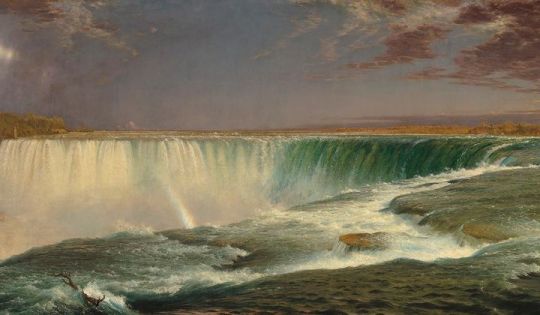


Niagra by Frederic Edwin Church, 1957
(National Gallery of Art, Corcoran Collection, Museum Purchase, Gallery Fund)
It’s hard to overstate Humboldt’s popularity during his heyday—the late 18th and early-to-mid-19th centuries. Widely traveled and broadly known in Europe, he was able to secure backing from the King of Spain to travel throughout South America, Mexico and Cuba between 1799 and 1804, documenting plant life, geology, climates, peoples and discovering the location of the magnetic equator, allowing him to “recalibrate his equipment and take the most accurate readings to that point of longitude and latitude in the Americas,” according to Harvey.
His book, Personal Narrative of Travels to the Equinoctial Regions of the New Continent during the Years 1799–1804, and other writings, excerpted in newspapers, gained him fans in the United States. Humboldt arranged a stopping over in America at the end of the southern hemisphere journey, primarily to meet President Thomas Jefferson, who “he suspected was his intellectual equal,” but also to get a close-up look at democracy and to possibly explore the Louisiana Territory, says Harvey.
He was greeted like a rock star by Peale when he disembarked in Philadelphia and feted by other intellectuals during his visit. He arrived in America at an auspicious time, says Harvey. Humboldt believed that the nation should capitalize on its natural wonder—that places like Niagara Falls and Natural Bridge in Virginia (on land owned by Jefferson) were just as monumental as European castles and cathedrals.

The Natural Bridge, Virginia by Frederic Edwin Church, 1852
(The Fralin Museum of Art at the University of Virginia, Gift of Thomas Fortune Ryan)
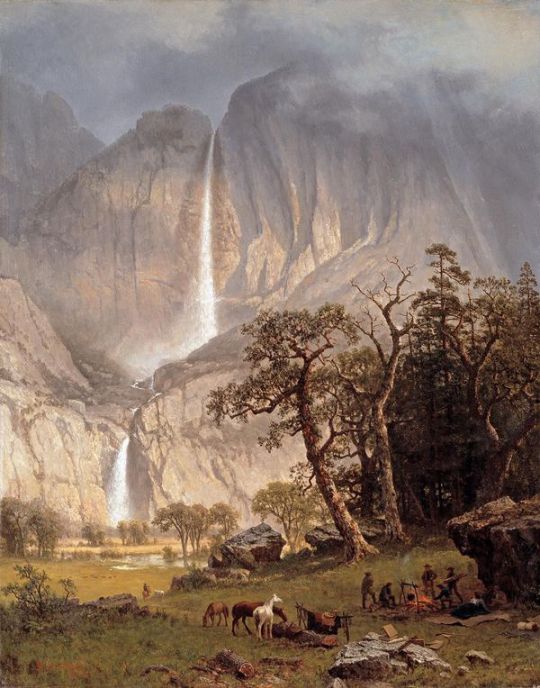
Cho-Looke, The Yosemite Fall by Albert Bierstadt, 1864
(Timken Museum of Art, Putnam Foundation)
The Peale mastodon—exhumed in upstate New York in 1801—fed into the mythology Jefferson hoped to create: that everything in America was bigger and better. Mammoth mania took over America after Peale displayed the fossil at his Philadelphia museum in late 1801. The unearthing of the bones is magnificently recalled in Peale’s 1806 painting, Exhuming the First American Mastodon.
Humboldt had written to Jefferson hoping to finagle an invite to the White House by mentioning that he’d found some mammoth teeth in the Andes. It worked, and he soon found himself hobnobbing with a network of American politicians, painters, writers and scientists. Among those who became a part of the Humboldt Hive: James Fenimore Cooper, Edgar Allan Poe, John Muir, Henry David Thoreau, Frederic Church, Walt Whitman and Samuel F.B. Morse.
The Prussian eventually came to consider himself half-American. Though he never visited the U.S. again after the 1804 trip, American luminaries frequently came to his Paris residence to bask in his presence. By 1847, Humboldt had been made a member of seven American scientific and cultural organizations.
Humboldt inspired a bevy of artists to ground their work in nature, including some of the greatest landscape painters of the time, Albert Bierstadt and Church. Twenty works by Church and two of Yosemite by Bierstadt are featured in the exhibition. Church’s paintings of Niagara Falls, Natural Bridge, and several Andean peaks, which he visited during a trip that recreated, step-by-step, Humboldt’s expedition through the same region, transport the viewer into a towering vision of nature.
Throughout his travels and his life, Humboldt was an advocate for social justice. “He thought the one flaw in American democracy was that it would not abolish slavery,” says Harvey. He urged James Madison to consider ending slavery, telling him that “nature is the domain of liberty.” Humboldt backed the anti-slavery 1856 presidential candidacy of John C. Fremont—who, during earlier explorations of the American west that were inspired by Humboldt, paid tribute to the scientist by naming various features after him, including a river in Nevada.

Valley of the Yosemite by Albert Bierstadt, 1864
(Museum of Fine Arts, Boston, Gift of Martha C. Karolik for the M. and M. Karolik Collection of American Paintings)
The plight of Native Americans also concerned Humboldt, especially in the wake of the Indian Removal Act of 1830. He convinced Prince Maximilian zu Wied-Neuwied, a protégé, and artist Karl Bodmer, to replicate part of the Lewis and Clark expedition to document the tribes of the Upper Missouri River. The exhibition features excerpts from the Prince’s journals and finely detailed watercolors of tribe members executed by Bodmer.
Humboldt also became friends with artist George Catlin, who had begun immersing himself in the documentation of America’s vanishing tribes starting in 1830. They meet in Paris, where Catlin has brought his portraits of Native Americans and a group of people from the Iowa tribe to educate the French—and shore up his dwindling finances. “It is the first and only time Humboldt will meet North American Indians,” says Harvey. Humboldt ends up touring the Louvre with some members of the tribe, one of whom kept a diary of the events of that trip.
A number of original Catlin portraits are on display, as is an 1845 painting depicting the visit to France, Karl Girardet’s Danse d’indiens Iowas devant le roi Louis-Philippe aux Tuileries (Dance of the Iowa Indians before the King Louis-Philippe at the Tuileries).
Not surprisingly, Humboldt is even connected with the founding of the Smithsonian Institution. When the Prussian traveled to England in 1790 to connect with a mentor there, he also ended up being introduced to a young chemist, James Smithson—the same Smithson whose bequest eventually created the Smithsonian in 1846.
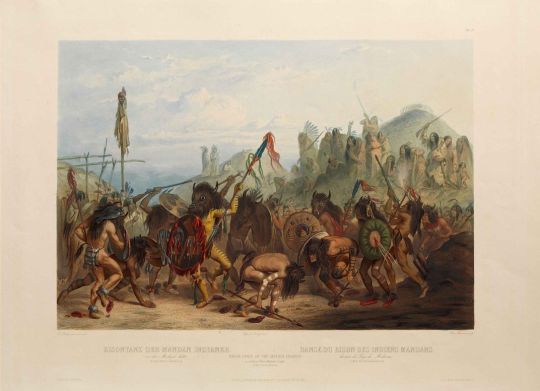
Bison Dance of the Mandan Indians in front of Their
Medicine Lodge in Mih-Tutta-Hankush by Alexandre Damien Manceau, engraver, after Karl Bodmer
(Joslyn Art Museum, Omaha Nebraska; 1986.49.542.18, Photograph © Bruce M. White, 2019)
The two reconnected in Paris in 1814, and spent a year in friendship, hanging out with liberal pro-American and pro-Democracy factions—making Smithson a bit of an outlier among his British compatriots. Humboldt and Smithson shared a love of collecting and analyzing, and spreading knowledge.
Well before the Smithsonian was established, Peale had already envisioned a national institution dedicated to the arts, sciences and American ideals and asked Humboldt to convince Jefferson to buy his museum collection as the foundation. Jefferson wasn’t interested in purchasing Peale’s materials. But the idea of a national institution continued to be discussed in Washington and elsewhere for decades. In 1835, Smithson’s last heir died and the estate was then, as directed by Smithson, bequeathed to the U.S. After much debate, Congress decided to accept the money. American attorney Richard Rush was dispatched to London to bring the dollars home, to, as Smithson put it, “found at Washington, under the name of the Smithsonian Institution, an Establishment for the increase & diffusion of knowledge among men.”
Those words “are a Humboldtian credo,” writes the museum’s director Stephanie Stebich in the introduction to the exhibition catalog. Most of the men ultimately involved in setting up the Smithsonian Institution had either known Humboldt, corresponded with him, or admired him, says Harvey.
“The entire Smithsonian is in some ways the bricks and mortar realization of everything that Humboldt cared about,” she says. The Institution’s 19 museums, the National Zoo, and 21 research centers and programs encompass Humboldt’s vast interests.
To make that point, the final gallery in the show features nine ongoing Smithsonian projects “that reflect Humboldtian enterprise,” says Harvey.
Though Humboldt was celebrated throughout the 19th century—with big parties in American cities every decade starting in 1869—the rise of Germany as a hostile power in the early 20th century caused Americans to stop teaching about the great scientist. Essentially, the lights went out on Humboldt, says Harvey.
“I’m trying to turn the lights back on and dust for his fingerprints, and say, ‘hey, he was here, and here and here,’” she says.
Currently, to support the effort to contain the spread of COVID-19, all Smithsonian museums in Washington, D.C. and in New York City, as well as the National Zoo are temporarily closed. The exhibition “Alexander von Humboldt and the United States: Art, Nature, and Culture” goes on view at the Smithsonian American Art Museum in 2020.
Listen to Sidedoor: A Smithsonian Podcast
It took a zealous Prussian explorer to show the colonists what they couldn’t see: a global ecosystem, and their own place in nature. Check out this season five episode, “The Last Man Who Knew It All,” about Alexander von Humboldt.
#Nature
1 note
·
View note
Text
It’s still the 70s, but with more guitar
Across from Punk, the way the guitar was being utilized was starting to formulate more intricate like and kick ass than ever before. Becoming the center piece, the shift into guitar chops would see prominence in such classics as Ram Jam’s Black Betty.
youtube
At some point, guitar solos had started to become a rite of passage. It’s not the first time guitar mastership was introduced, but it certainly became a mainstay into rock and the newly developed Metal genre.
youtube
Crazy Train - Ozzy Osbourne (1980)
Randall “Randy” Williams Rhoads (1956 - 1982)

Randy was an American heavy metal guitarist who played with Quiet Riot and Ozzy Osbourne. A devoted student of classical guitar, Rhoads combined his classical music influences with his own heavy metal style. He died in a plane accident while on tour with Osbourne in Florida in 1982. Despite his short career, Rhoads, who was a major influence on neoclassical metal, is cited as an influence by many guitarists. Rhoads is included in several "Greatest Guitarist" lists.
Source: Wikipedia

Randy with his collection of signature Jackson Flying V guitars and his Gibson Les Paul.
There was a major boom in the U.K. that took place as early as the 1960′s when many associated artists and acts would take inspiration from the U.S. and the Blues music. This would lead into the New Wave of British Heavy Metal or in acronym, N.W.O.B.H.M. Punk scenes were taking place in most the world in the emerging 1970s. Bands such as The Beatles and Led Zeppelin have gone on record to have stated taking great strides from Blues musicians such as Muddy Waters.
The new wave of British heavy metal (commonly abbreviated as NWOBHM) was a nationwide musical movement that started in the United Kingdom in the late 1970s and achieved international attention by the early 1980s. Journalist Geoff Barton coined the term in a May 1979 issue of the British music newspaper Sounds to describe the emergence of new heavy metal bands in the mid to late 1970s, during the period of punk rock's decline and the dominance of new wave music.
Source: Wikipedia
youtube
Phantom of the Opera (2015 Remaster) - Iron Maiden (1980)
Of cultural importance the band would create their songs based around historical events. To think that I have learned a bit more about world history from Iron Maiden than some of my own school history textbooks is quite exemplary of the band. The stories told in these songs are taken from real world events. One such song would be Run to the hills. A song which explains the colonialism of the Americas and the brutal ways the Colonists established territory fighting the indigenous natives. I can only imagine textbooks these days gloss over such pivotal moments in world history.
youtube
Run to the Hills (1998 Remaster) - Iron Maiden (1985)

Eddie, the iconic character from Iron Maiden. He is often depicted in the real world events that Iron Maiden bases their songs on. This one is The Trooper, reference to the Charge of the Light Brigade at the Battle of Balaclava 1854, which took place during the Crimean War.
Meanwhile back in the U.S. another band would help establish the guitar’s role to shape the Rock and Roll landscape.

The original Van Halen logo as seen on their debut self titled album.
Van Halen is an American hard rock band formed in Pasadena, California in 1972. Credited with "restoring hard rock to the forefront of the music scene", Van Halen is known for its energetic live shows and for the work of its acclaimed lead guitarist, Eddie Van Halen. The band was inducted into the Rock and Roll Hall of Fame in 2007.
Source: Wikipedia

From left to right David Lee Roth, Alex Van Halen, Eddie Van Halen, and Michael Anthony.
From 1974 until 1985, Van Halen consisted of Eddie Van Halen; Eddie's brother, drummer Alex Van Halen; vocalist David Lee Roth; and bassist Michael Anthony. Upon its release, the band's self-titled debut album reached No. 19 on the Billboard pop music charts. By the early 1980s, Van Halen was one of the most successful rock acts of the time. The album 1984 was a hit; its lead single, "Jump", is the band's only U.S. number one single to date and was internationally known.
Source: Wikipedia

In 1985, Van Halen replaced Roth with former Montrose lead vocalist Sammy Hagar. With Hagar, the group released four U.S. number-one albums over the course of 11 years (5150 in 1986, OU812 in 1988, For Unlawful Carnal Knowledge in 1991, and Balance in 1995). Hagar left the band in 1996 shortly before the release of the band's first greatest hits collection, Best Of – Volume I. Former Extreme frontman Gary Cherone replaced Hagar, remaining with the band until 1999; Van Halen then went on hiatus until reuniting with Hagar for a worldwide tour in 2003. The following year, the band released The Best of Both Worlds, its second greatest hits collection. Hagar again left Van Halen in 2005; in 2006, Roth returned as lead vocalist. Anthony was fired from the band in 2006 and was replaced on bass guitar by Wolfgang Van Halen, Eddie's son. In 2012, the band released the commercially and critically successful A Different Kind of Truth.
As of March 2019, Van Halen is 20th on the RIAA list of best-selling artists in the United States; the band has sold 56 million albums in the States and more than 80 million worldwide, making them one of the best-selling groups of all time. As of 2007, Van Halen was one of only five rock bands with two studio albums that sold more than 10 million copies in the United States. Additionally, Van Halen has charted 13 number-one hits in the history of Billboard's Mainstream Rock chart. VH1 ranked the band seventh on a list of the top 100 hard rock artists of all time.
Source: Wikipedia

The change in lineup during the Hagar era was viewed as one of the most controversial and most discussed among music fans over the years. A lot of of original fans turned their backs and retaliated against the new singer. Sammy has still not felt any malice since joining and leaving the band. And personally, I grew up with the album 5150 first. I thought it was really great among some of the David Lee Roth era material as well. I really dig both singers for what they brought to the band. But no matter what, when you set the bar a certain height, filling in that role will always be a major undertaking. When I listened to their earlier songs such as I’m the one, Ice Cream Man, and Romeo Delight really capture the band in it’s purest form. And then along came the most sought after guitar solo ever captured in history.
youtube
The outrageous barrage of notes as it’s come to be known is the mighty behemoth, the unmistakable, the renowned Eruption written by Eddie Van Halen. Once this solo was released, all Hell broke loose. Everybody wanted to get in on that guitar shred goodness. Funny thing is though, the word Shred wouldn’t even be a household name until mid to late 80′s.
It goes without saying that every guitarist at some point has heard of or knows of Eddie Van Halen. I think Eruption was the biggest monument attributed to that. And I just like every other kid would hear this for the first time and would just be blown away and ignited to dedicate my guitar chops. Which would be beneficial to up and coming musicians willing to go the distance.
Diver down will always be my favorite album, mostly because it features two guitar solos. And if you enjoyed Eruption, you absolutely will love Cathedral and Spanish Fly.
I kinda took Diver down as a format for my own first released album, Allegro. Opening with a guitar solo, and having some (poorly recorded) Heavy Rock tracks ending in a final guitar solo.
Since we’re discussing Van Halen’s legacy, I would be remiss if I left out the history post Van Halen and David Lee Roth’s solo project, A little ain’t enough.

So based off of what I personally know, David splits from VH, and starts his own side project in late 80s till 1990. He looks around for guitarists. By some miracle he finds Jason Becker. I’ll go deeper in a detailed entry about Jason, but know this; Jason left his own band Cacophony to release a solo album and sent Roth in a demo tape. Dave liked what he heard and immediately signed Jason on contract to record A little ain’t enough. The recording has been completed and Jason is set to tour to promote the album. Except, health complications prevented Jason from attending rehearsals and eventually from the tour at the advice of his doctor. He had been diagnosed with ALS (Ameotrophic Lateral Sclerosis, aka Lou Gehrig’s Disease). The album’s tour tanked in live shows and marked Roth’s decline in commercial success.
The demo that Jason sent in was actually a cover of Yankee Rose, the guitarist on the original track was Steve Vai.
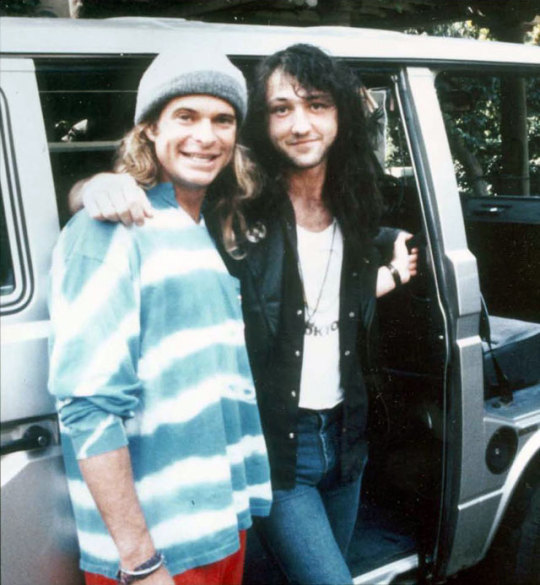
2 notes
·
View notes
Text
Day 7!
This morning we had yet another long, historical tour. This one was led by Emperor Norton, one of the more colorful characters from San Francisco history. He took us around the city for nearly three hours, and though we had already heard some of the stories, he told them better!
Some fun things we learned:
Joshua Abraham Norton was born in 1818, immigrated to the U.S., and in only four years, amassed a fortune of what today would be about $10 million. But he played his cards wrong, lost his money, and disappeared for a couple of years. Upon his return, he gave a letter to the newspaper to print (and they did) that declared he was now the Emperor of the United States.
Here’s where the story really gets interesting: the city of San Francisco decided to play along!
He was given an official, royal uniform, people in the streets began saluting him, restaurants gave him food for free, the newspapers printed his “proclamations,” and the stores accepted bonds from “the imperial government of Norton I,” which promised payment with interest in the year of 1880. Of course, he died in 1880, and it turned out he was dirt poor, and his “bonds” were worth diddly squat. But people must have been pretty fond of him, because a collection went around for his funeral, and around 200,000 people marched through the streets behind his coffin, and it remains the most attended funeral in San Francisco history.
Also:
We learned that the term “Sugar Daddy” comes from San Francisco! Alma de Bretteville was born very poor, but her life’s ambition was to marry a millionaire. She accomplished this by modelling for art. She was the model for the Goddess of Victory atop a monument erected in Union Square for Admiral George Dewey after the Spanish-American War, and this brought her to the attention of Adolph Spreckles, who was much older than she was but was a millionaire, was smitten with her, and, most importantly, was the head of Spreckles Sugar Company. That’s right; this much older, wealthy man she married was the head of a sugar company. For this reason, she referred to her husband as her sugar daddy.
You learn knew things every day, huh?
We had lunch at Francis Ford Copppla’s Cafe Zoetrope. It’s a big, beautiful green building in San Francisco with his restaurant on the bottom floor, the offices of his production company in the middle, and an apartment where he stays on the top. The food was very good, too!
We decided to end our afternoon with a jaunt to Land’s End so we could actually touch the Pacific Ocean. The internet told us it was a short, leisurely hike to get to the stretch of beach you could actually access, and we wouldn’t even break a sweat. The internet, it seems, is full of LIES.
“Let’s go the beach,” Caitlyn said. “It’ll be fun,” Caitlyn said. “I want to die,” Caitlyn said.
Once again, we found ourselves climbing MOUNTAINS followed by an ungodly number of stairs, and the stairs were too wide, which made them take longer to climb, and they were even difficult to use when traipsing down.
We made it to the beach, thankfully. It was a fun time: we touched the water with the tips of our fingers, sat on a log, and searched for rocks. We each found one immediately that we wanted to keep, but I wasn’t sure about mine, so Caitlyn spent the next hour helping me look for another, only for me to decide that I was, in fact, going to keep the very first one I found. Sometimes you have to spend time with the wrong rocks to appreciate the right rock! Anyway, we started the slow, torturous journey back eventually, and we survived, but Caitlyn claims a piece of her soul died on the way back.
I guess this means we officially prefer the Atlantic Ocean.
P.S. Caitlyn says the right rock for her was not at the Pacific Ocean, because the right rock for her is THE Rock, Dwayne The Rock Johnson.
1 note
·
View note
Photo

Thousands of threads connect us all together and the times when I feel connected to the past, are the times when I feel the most at peace. Our actions ripple out into the world as causes and come back to us as effects, and we cannot live only for ourselves. #colorado #hiking #adventure #inspiration #newspaperrock #mountains #nativeamerican #petroglyphs #utah (at Newspaper Rock State Historic Monument)
4 notes
·
View notes
Note
do you know anything about Jehovah’s Witnesses using programming?
The Jehovah’s Witnesses use cult methodologies within their teachings, and are considered a cult by many.
Some of the methods are love bombing new members, financial control, if a member leaves they are shunned, and members can’t question authority.
If someone’s entire family are members of the Jehovah’s Witnesses this makes leaving a monumental undertaking.
The methods of control used by the Jehovah's Witnesses and other cult groups follow the BITE model (Steven Hassan.)
Behavior Control
1. Regulate individual’s physical reality2. Dictate where, how, and with whom the member lives and associates or isolates3. When, how and with whom the member has sex4. Control types of clothing and hairstyles5. Regulate diet - food and drink, hunger and/or fasting6. Manipulation and deprivation of sleep7. Financial exploitation, manipulation or dependence8. Restrict leisure, entertainment, vacation time9. Major time spent with group indoctrination and rituals and/or self indoctrination including the Internet10. Permission required for major decisions11. Thoughts, feelings, and activities (of self and others) reported to superiors12. Rewards and punishments used to modify behaviors, both positive and negative13. Discourage individualism, encourage group-think14. Impose rigid rules and regulations15. Instill dependency and obedience16. Threaten harm to family and friends17. Force individual to rape or be raped18. Instill dependency and obedience19. Encourage and engage in corporal punishment
Information Control1. Deception:
a. Deliberately withhold information
b. Distort information to make it more acceptable
c. Systematically lie to the cult member
2. Minimize or discourage access to non-cult sources of information, including:
a. Internet, TV, radio, books, articles, newspapers, magazines, other media
b.Critical information
c. Former members
d. Keep members busy so they don’t have time to think and investigate
e. Control through cell phone with texting, calls, internet tracking
3. Compartmentalize information into Outsider vs. Insider doctrines
a. Ensure that information is not freely accessible
b.Control information at different levels and missions within group
c. Allow only leadership to decide who needs to know what and when
4. Encourage spying on other members
a. Impose a buddy system to monitor and control member
b.Report deviant thoughts, feelings and actions to leadership
c. Ensure that individual behavior is monitored by group
5. Extensive use of cult-generated information and propaganda, including:
a. Newsletters, magazines, journals, audiotapes, videotapes, YouTube, movies and other media
b.Misquoting statements or using them out of context from non-cult sources
6. Unethical use of confession
a. Information about sins used to disrupt and/or dissolve identity boundaries
b. Withholding forgiveness or absolution
c. Manipulation of memory, possible false memories
Thought Control1. Require members to internalize the group’s doctrine as truth
a. Adopting the group's ‘map of reality’ as reality
b. Instill black and white thinking
c. Decide between good vs. evil
d. Organize people into us vs. them (insiders vs. outsiders)
2.Change person’s name and identity
3. Use of loaded language and clichés which constrict knowledge, stop critical thoughts and reduce complexities into platitudinous buzz words
4. Encourage only ‘good and proper’ thoughts
5. Hypnotic techniques are used to alter mental states, undermine critical thinking and even to age regress the member
6. Memories are manipulated and false memories are created
7. Teaching thought-stopping techniques which shut down reality testing by stopping negative thoughts and allowing only positive thoughts, including:
a. Denial, rationalization, justification, wishful thinking
b. Chanting
c. Meditating
d. Praying
e. Speaking in tongues
f. Singing or humming
8. Rejection of rational analysis, critical thinking, constructive criticism
9. Forbid critical questions about leader, doctrine, or policy allowed
10. Labeling alternative belief systems as illegitimate, evil, or not useful
Emotional Control1. Manipulate and narrow the range of feelings – some emotions and/or needs are deemed as evil, wrong or selfish
2. Teach emotion-stopping techniques to block feelings of homesickness, anger, doubt
3. Make the person feel that problems are always their own fault, never the leader’s or the group’s fault
4. Promote feelings of guilt or unworthiness, such as
a. Identity guilt
b. You are not living up to your potential
c. Your family is deficient
d. Your past is suspect
e. Your affiliations are unwise
f. Your thoughts, feelings, actions are irrelevant or selfish
g. Social guilt
h. Historical guilt
5. Instill fear, such as fear of:
a. Thinking independently
b. The outside world
c. Enemies
d. Losing one’s salvation
e. Leaving or being shunned by the group
f. Other’s disapproval
6. Extremes of emotional highs and lows – love bombing and praise one moment and then declaring you are horrible sinner
7. Ritualistic and sometimes public confession of sins
8. Phobia indoctrination: inculcating irrational fears about leaving the group or questioning the leader’s authority
a. No happiness or fulfillment possible outside of the group
b. Terrible consequences if you leave: hell, demon possession, incurable diseases, accidents, suicide, insanity, 10,000 reincarnations, etc.
c. Shunning of those who leave; fear of being rejected by friends, peers, and family
d. Never a legitimate reason to leave; those who leave are weak, undisciplined, unspiritual, worldly, brainwashed by family or counselor, or seduced by money, sex, or rock and roll
e. Threats of harm to ex-member and family
20 notes
·
View notes
Video
Petroglyphs and Prehistoric Rock Art at the Newspaper Rock State Historic Monument by Mark Stevens
Via Flickr:
As I'd begun to plan this trip with the many stops at national parks and monuments, a co-worker had mentioned this as a place worthy of a stop. For this image, I focused on one section that seemed to be covered from edge to edge with stories and art. I felt that that best captured the idea for this monument. Anyone could then image all the stories and history being written and told...
#Along Utah State Route 211#Ancient Pueblo Rock Art#Azimuth 66#Capture NX2 Edited#Color Efex Pro#Day 4#Desert Landscape#Desert Mountain Landscape#Desert Plant Life#High Desert#Indian Creek Canyon#Indian Creek Corridor#Indian Creek Corridor Scenic Byway#Indigenous Rock Art#Landscape#Looking ENE#National Register of Historic Places#Nature#Newspaper Rock#Newspaper Rock Recreation Site#Newspaper Rock State Historic Monument#Nikon D800E#Outside#Petroglyphs#Prehistoric Rock Art#Project365#State Route 211#Sunny#Tse' Hone#Utah High Desert
0 notes
Text
Exploring Utah’s Mighty Monuments: Bears Ears and Grand Staircase-Escalante
Utah has among the most lovely—and most crowded—nationwide parks within the nation. That’s why you need to take a look at the state’s much less visited monuments, Bears Ears and Grand Staircase-Escalante, whilst you nonetheless can. Relating to accessible out of doors motion, America’s nationwide monuments usually outshine our nationwide parks anyway. You’ll be able to trip a mountain bike off-road. You’ll be able to deliver your canine and camp virtually anyplace. More often than not, there’s no entry price. What extra might you ask for?
Within the case of Utah’s Mighty Monuments, you may ask to have them again, for starters.
As soon as acknowledged among the many largest nationwide monuments managed by the U.S. Bureau of Land Administration (BLM), Grand Staircase-Escalante and Bears Ears have suffered the most important rollback of public lands protections in U.S. historical past. Regardless of ongoing authorized challenges, a pair of doubtful presidential proclamations designed to dismember these monuments have been lately set in movement, successfully slashing Bears Ears by 85 p.c and Grand Staircase by about half.
The adopted administration plans unveiled by the Inside Division in February enable for mining, drilling and different growth on huge swaths of the acres the Trump administration carved out of Bears Ears and Grand Staircase-Escalante, nationwide monuments designated by Presidents Barrack Obama and Invoice Clinton to protect the distinctive geology, cultural treasures and iconic Western landscapes.
For the second, the modifications are solely on paper. It’s (nonetheless) not clear {that a} president has the authority to abolish or shrink nationwide monument boundaries, so the sinuous slot canyons, slickrock trails, sheer cliffs and spires that outline the area stay accessible. These lands current countless alternatives for climbers, canyoneers, mountain bikers, boaters, fly-fishermen and adventurers at massive.
Expertise and get pleasure from these magnificent monuments whilst you can—earlier than they turn out to be fodder for a somber John Prine music, as a result of there’s no telling how lengthy earlier than “Mr. Peabody’s coal prepare hauls it away.”
Paddling the San Juan River under Mexican Hat, Utah. Andrej Safaric / Shutterstock
Bears Ears Nationwide Monument
Go With the Circulate: The postcard-picture outpost of Bluff, Utah, is the launch level for all issues Bears Ears, together with the Bears Ears Schooling Heart, which gives info on every thing from archeology to journey. It’s additionally the staging web site for one of many nation’s premier desert river runs on the San Juan River. The Class II float from the close by BLM boat launch/campground at Sand Island to the takeout at Mexican Hat flows 27 miles alongside the southern border of Bears Ears’ Shash Jáa Unit and presents ample side-hikes to discover the world’s archeology, geology and wildlife. Lengthen your journey right down to Clay Hills for an 84-mile multi-day immersion into the canyonlands. The mellow, meandering San Juan is good for all skills and virtually any kind of vessel, however you’ll want a allow to launch a non-public journey. In any other case, native clothing store Wild Expeditions can deal with all of the gritty particulars.
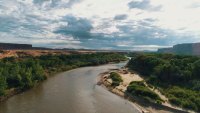
A few of the Finest Paddling within the Southwest is in Utah’s Southeast
The gateway to Bears Ears boasts among the finest water on the San Juan River.
Learn article
Cruising the Valley of the Gods. oksana.perkins / Shutterstock
Make Peace With Your Gods: Technically not a part of BENM, the gorgeous 17-mile spur route often known as Valley of the Gods is a masterpiece of sandstone monoliths, pinnacles and buttes. The highway is graded gravel and clay, providing fair-weather entry to most automobiles together with mountain bikes, though off-road journey just isn’t an possibility. Dispersed tenting on surrounding BLM lands is obtainable, together with a number of scenic stops to seize a pack and discover the panorama.
Newspaper Rock, one of many largest identified collections of historical petroglyphs, situated in Indian Creek State Park. Abbie Warnock / Shutterstock
Climb the Creek: Indian Creek is the undisputed epicenter of crack climbing, providing trad rock climbers a nearly countless array of splitters alongside the huge partitions resulting in the Needles District of Canyonlands Nationwide Park. The namesake of Bears Ears’s revised northern unit is on the must-do checklist for each core climber, however native guides and clinics assist make the scene accessible for mere mortals. If , mountain climbing is a pure alternative, usually with the bonus of historical artifacts. The roadside Newspaper Rock is basically a 2,000-year-old Instagram feed with over 650 photos pecked into the varnished sandstone.
Decrease Calf Creek Falls in Grand Staircase-Escalante Nationwide Monument. Kris Wiktor / Shutterstock
Grand Staircase-Escalante Nationwide Monument
Get Misplaced: There’s a purpose the rugged labyrinth of canyons, creeks, cliffs and terraces surrounding Escalante was the final place within the decrease 48 to be mapped. Spooky Gulch, Zebra Slot Canyon and Coyote Gulch are among the many many mysterious stone mazes value exploring, and the 130-foot-high Decrease Calf Creek Falls rewards hikers with a cool plunge pool after a three-mile trek. Bonus factors for packing in a fly rod to land one of many resident trout. Go to Escalante Outfitters on the town for gear, beer and information service in and across the monument.
Mountain climbing Coyote Gulch in Grand Staircase-Escalante Nationwide Monument. Kris Wiktor / Shutterstock

Uncovering the Wonders of Utah’s Grand Staircase-Escalante Nationwide Monument
This place is awe inspiring, however with the proper information your thoughts will probably be really blown.
Learn article
Go Lengthy: The Escalante River Canyon presents the monument’s holy grail of journey in a distant 73-mile self-supported kayak or packraft (or SUP) tour touchdown in Lake Powell. Fundamental Class III abilities are sufficient to navigate the rapids, though the most important problem lies in hitting the seasonal candy spot for fickle river flows. In excessive or low water, the unique canyon options greater than a dozen side-hikes into gorgeous slot canyons and alongside feeder streams crammed with wild trout. Permit three to seven days to savor the canyon and ebook a ship shuttle from Powell’s Bullfrog Marina to attenuate logistical stress.
Subalpine meadows on the prime of Boulder Mountain on Aquarius Plateau. Serj Malomuzh / Shutterstock
Convey the Bike: Whereas Moab steals the headlines, plentiful slickrock, spectacular surroundings and secluded, technical trails make for a comparable mountain biker’s mecca at Grand Staircase-Escalante. The monument stays one of many largest roadless areas within the West, however singletrack trails vary from the excessive tableland of the Aquarius Plateau, throughout Hell’s Spine and into the hidden desert canyons that punctuate the panorama. The Slot Canyons Inn presents driving proper out the door whereas Rim Excursions out of Moab and Vegas-based Escape Adventures each present multi-day packages for various means ranges (at each GSENM and BENM).

5 Socially Distant Adventures to Be Had within the Southwest
Learn article
Authentic supply: https://www.mensjournal.com/adventure/adventure-guide-bears-ears-and-grand-staircase-escalante-monuments/
0 notes
Photo
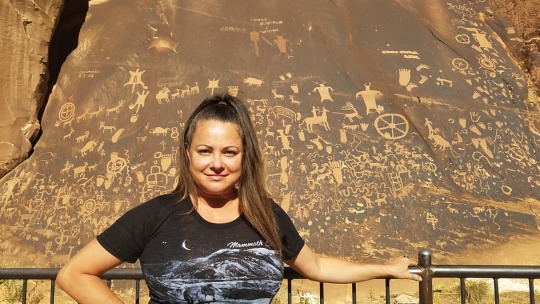
A petroglyph etched in the rock by the Navajo describing 2000 years of history starting before Christ. Known as "the rock that tells a story" yet it has never been deciphered. #petroglyphs #roadtrip2020 #Navajo #newspaperrock #utah #family #adventure (at Newspaper Rock State Historic Monument) https://www.instagram.com/p/CD_-FsdAprW/?igshid=1cpxa6f8bcdtr
0 notes
